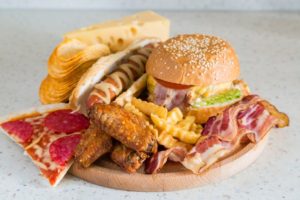
The primary causes of NAFLD include obesity, insulin resistance, high blood sugar, and high levels of fat. Risk factors include high cholesterol, high triglycerides in the blood, metabolic syndrome, obesity, polycystic ovary syndrome, sleep apnea, type 2 diabetes, underactive thyroid, and underactive pituitary gland.
Whether you have been diagnosed with NAFLD or not, diet plays a large role. For patients with NAFLD, eating the right foods can help reduce symptoms and slow down disease progression. Among those without NAFLD, a poor diet may increase their risk of developing it.
The British Liver Trust has compiled a list of foods which should be avoided, especially if you have NAFLD. The theme of many of these foods is that they are high in fat. If you have NAFLD, you definitely want to cut back on fat. These foods include:
- Butter, margarine, lard, drippings, or mayonnaise
- Cream and full-cream milk
- Full fat cheese
- Cooking oils like olive, sunflower, and vegetable oil
- Fatty meats
- Processed meats like sausage and bacon
- Chips and nuts
- Processed foods like baked goods, muffins, cookies, cakes
- Ready-to-eat meats
Swapping high-fat items with skim or low-fat alternatives is an excellent way to still enjoy some of these foods without intaking too much fat. Another easy swap is switching up high-fat meat cuts with leaner ones.
Lastly, preparing and cooking the bulk of your own meals at home is a good way to control the fat content in your diet better. If you do need to eat out then read menus carefully and make appropriate swaps when you can.
Also read:
- NAFLD diet plan: Dietary guidelines for non-alcoholic fatty liver disease
- What causes liver pain?
- 6 signs that your liver is in trouble